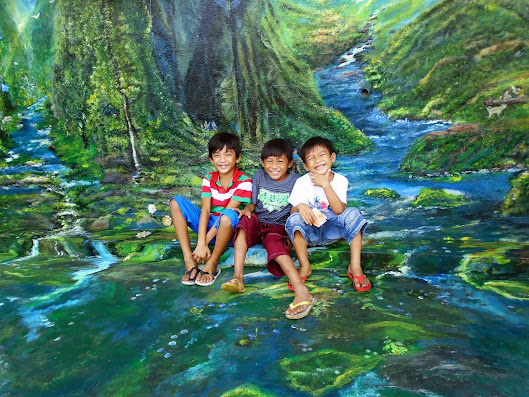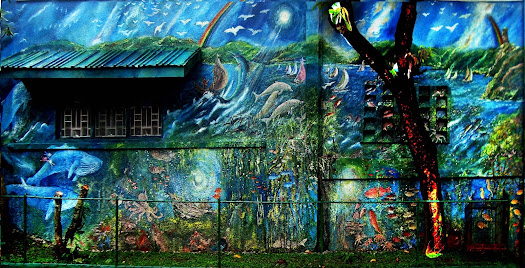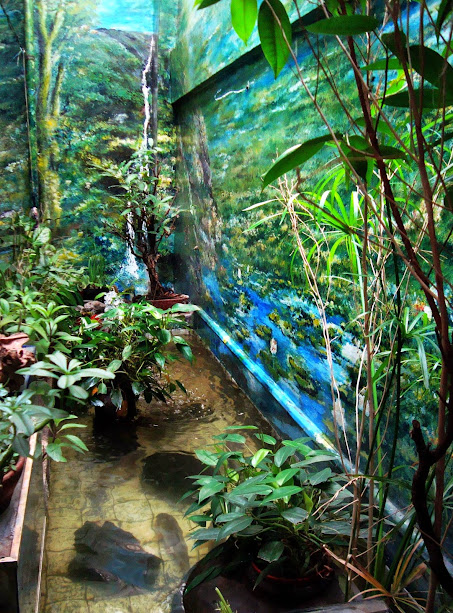Cryptobiology is a controversial field of study at the border of science and superstition, thus scientists call it pseudoscience. It is however, gaining acceptance and support from scholars and people in general.
Coed Angie Tobias 19, poses with driftwood specimens resembling the Philippine eagle and another descendant of the extinct Archaeopteryx.
There are two fields of cryptobiology, one concerning animals (cyptozoology) and the other, plants (cryptobotany). The former took off with the discovery of strange creatures like the Coelacanth fish thought to have become extinct millions of years ago. On the other hand, the search of legendary and fiction characters like Loch Ness, Bigfoot, and the Abominable Snowman, continues to draw attention.
Ms Melly C Tenorio, host, and Dr Abe V Rotor, guestSearch for the Incredible
Media with the advancement of science and technology have embellished findings and reports about a "third world of creatures". The platypus is among nature's most unlikely animals. In fact, the first scientists to examine a specimen believed they were the victims of a hoax. If the Red Wood (Sequoia) was not discovered, no one would believe in its enormous size compared with high rise buildings. How many creatures completely unfamiliar to most of us live in a drop of pond water? In terms of biological diversity, 90 percent of living things remain unknown and unidentified, more so if we include the prototype and extinct organisms since life appeared three billion years ago.


- Cryptobiology: Study of creatures around myths and beliefs *Cryptobiology is the study of cryptids, creatures around which myths exist but whose current existence has never been verified. Some famous cryptids include bigfoot, the Loch Ness monster, and the chupacabra. Cryptids are elusive creatures that dance on the fringes of human perception, whose existence has not been proven by science, but has been reported by many eye-witnesses. Modern science has proved the existence to creatures that existed only in imagination and fantasy.
- Cryptobiology is traced to our ancestors, and carried on through history, treasured in primitive societies, religious organizations, and time honored beliefs and tradition conveyed in documents and folktales.
- Cryptobiology, Keeper of Values and Tradition One time I asked a man of his true name. He said when he was a boy he was sickly. To overcome his condition, his nickname was changed with one stroke of a bolo (Taga' sa punong kahoy.) To this day Mang Kapok (kapok is cotton tree, Ceiba pentandra), now a senior, is heathy and strong, thanks to the spirit of the place and the village herbolario.
- Beginning of Crypto communication. With the breakthrough in cybercommunication, it is evident that soon we will be communicating with Nature more directly than before, more than mere fantasy and imagination, over and above, inferential and psychological.
- Cryptobiology and Conscientization. Conscientizatrion conveys the idea of developing, strengthening, and changing consciousness. Consciousness leads us to think further than knowledge in the pursuit of values, truth and the ideal. Here is a piece I wrote for a university lecture on Nature and Literature. ~
I am the ghost that walksfrom a forest before;I am the conscience of mansleeping in its core.I am the memoryfrom the distant past;lost among the throng,living in the dust.I came from Paradise lost,orphaned by the First Sin;the hands that cared for mecan't now be seen.I long for a heaven, too,a gift of being good and true,but if heaven is only for man,I did serve him through.But I am a ghost now.Would man join me for a walkto tell the world the storyof a once mighty oak? ~
Author's Note: Is the kapre that dwells in old big trees true after all? Utter tabi tabi (bari bari Ilk) while making your way on an unbeaten path. Pour a few drops of your drink before you down your glass. Have you heard the song of a whale? How about that of a mermaid? Anaconda can grow up to 20 meters long! You are lucky if you can pick a leaf of makahiya (Mimosa pudica) fresh and not drooping. If you find a four-leaf clover don't miss the lottery. ~
Published Lagro Gazette Jan-Mar 2017 QC

Painting and Verse by Dr Abe V Rotor
She saw only the trees, not the forest;spots of red, not the loving pair,flowers, orchids, fluttering butterflies,and the peeping sunset but a glare.Thus we see ourselves more than others,Narcisian* syndrome we've fallen,leaving but Echo reverberating and dying;the forest, the lake all forsaken.
The original German title given to the work by Munch is, Der Schrei der Natur (The Scream of Nature). The Norwegian word skrik usually is translated as scream, but is cognate with the English shriek. Occasionally, the painting also has been called, The Cry.
In his diary in an entry headed, Nice 22 January 1892, Munch described his inspiration for the image:
Scream of NatureI hear nature scream from a lost eagle,owl hooting, starving on its roost,playful swallows thinned out of their flock,watchful crows abandon their post.
I hear nature scream in a dying river,brooks that laugh with the rainno more, so with children fishing then,rivulets in melodious strain.
I hear nature scream from the raging sea,rising and falling on the coral reef,the shores exploding, melting in foam,in muffled cries of pain and grief.
I hear nature scream - oil spill!too late the fish and birds to flee;black death blankets the tidal zone;fire is kind to end their agony.
I hear nature scream to the chainsaw,trees shrieking as they are felled,stripped to logs like bodies in Austerlitztheir stumps in Flanders Field.
I hear nature in the church prayingto save trees on Palm Sunday;to rebuild lost Eden for all creatures,for a Heaven here to stay. ~
Cattle ranch on a steep slope ripped off the skin of the mountain in Santa, Ilocos Sur - an example of the irreversible ill consequences of "Tragedy of the Commons." *
Sunken town of Pantabangan Nueva Ecija resurfaces during a extreme drought. Nature is sacrificed to human needs, more so to human wants in pursuit of affluence.
Death of cities is on the rise all over the world.
But more walls are built dividing cultures and politics.
























+p157+-+Copy.jpg)





.jpg)







































































